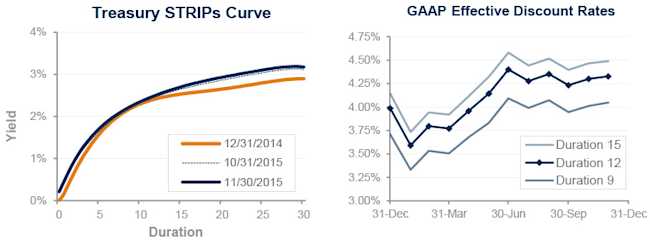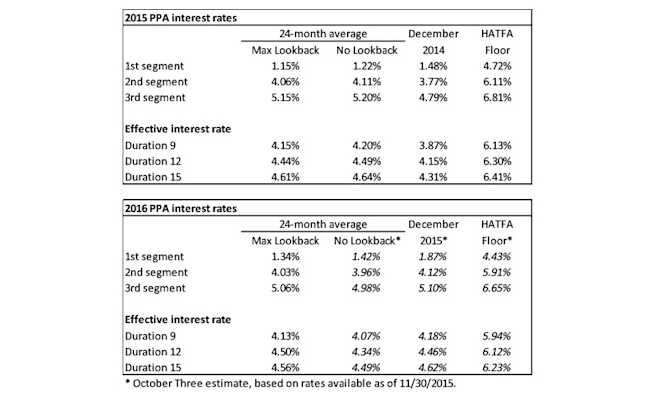November 2015 Pension Finance Update
November saw pension sponsors mostly tread water, consolidating gains from a strong October, in what is shaping up as a solid, if unspectacular, year for pension finances. Both model pension plans we track1 were close to flat last month: Plan A gained a fraction of 1% and is now ahead 4% on the year, while Plan B dropped a fraction of 1% but remains up almost 2% on the year through November.

Assets
Stocks mostly added marginally to October’s gains. The small cap Russell 2000 led the way, picking up 3%, while the NASDAQ added 1%, the S&P 500 was up a fraction, and the overseas EAFE index dropped a fraction. Through November, the NASDAQ remains the star for 2015, up 8%, while the S&P 500 has gained 3% and the Russell 2000 and EAFE index are both up 1%.
A diversified stock portfolio gained almost 1% in October, and is now up 3%-4% on the year.
Bonds lost less than 1% last month as interest rates edged up less than 0.1%. For the year, a diversified bond portfolio is about even- short duration bonds are up 1% or so, and long duration bonds are down 1%-2%.
Overall, our traditional 60/40 portfolio earned less than 1% in November and is now up 2%-3% for the year, while a conservative 20/80 portfolio was flat last month and remains flat to up 1% for the year.
Liabilities
Both funding and accounting liabilities are now driven by market interest rates. The graph on the left compares Treasury STRIPs yields at December 31, 2014, and November 30, 2015, and also shows the movement in rates last month. The graph on the right shows our estimate of movements in effective GAAP discount rates for pension obligations of various duration during 2015 so far:

Interest rates rose less than 0.1% during November. Corporate bond yields are now about 0.35% higher than at the end of 2014 and 0.75% higher than the all-time lows in January. Treasury yields are up 0.2% this year, as credit spreads have increased 0.15% during 2015.) Last month’s move pushed liabilities down 1%, leaving them 2% below their December 31, 2014 level- a bit less for short duration plans, and a bit more for long-duration plans.
Summary
As we said, 2015 is quietly looking like a solid year for pension finance. Assets have performed modestly, but higher interest rates have provided a tailwind, reducing pension liabilities a couple percent this year.

Looking Ahead
The Obama Administration and Congressional leaders passed a budget this fall that includes a third round of pension funding relief since 2012. The upshot is that pension funding requirements over the next several years will not be appreciably affected by current low interest rates (unless these rates persist). Required contributions for the next few years will be lower and more stable than under prior law.
Discount rates moved up a bit last month. Most pension sponsors are using rates of 3.8%-4.6% to measure pension liabilities for accounting purposes in today’s environment.
The table below summarizes rates that plan sponsors are required to use for IRS funding purposes for 2015, along with estimates for 2016. Pre-relief, both 24-month averages and December ‘spot’ rates, which are still required for some calculations, such as PBGC premiums, are also included.

1 Plan A is a traditional plan (duration 12 at 5.5%) with a 60/40 asset allocation, while Plan B is a cash balance plan (duration 9 at 5.5%) with a 20/80 allocation with a greater emphasis on corporate and long-duration bonds. For both plans, we assume the plan is 100% funded at the beginning of the year and ignore benefit accruals, contributions, and benefit payments in order to isolate the financial performance of plan assets versus liabilities.
